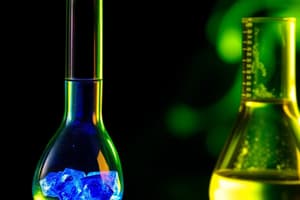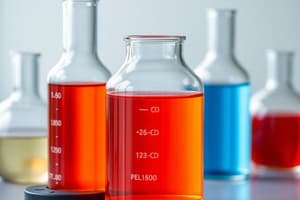Podcast
Questions and Answers
Which statement accurately describes the relationship between heat and temperature?
Which statement accurately describes the relationship between heat and temperature?
- Temperature measures the total energy of a system, while heat measures the average kinetic energy.
- Temperature is the rate at which energy is transferred, while heat is the total energy of a system.
- Heat is the transfer of energy, while temperature is a measure of the average kinetic energy. (correct)
- Heat and temperature are interchangeable terms that both measure average kinetic energy.
Considering the system and surroundings model, if a chemical reaction within a system releases heat, what can be correctly inferred?
Considering the system and surroundings model, if a chemical reaction within a system releases heat, what can be correctly inferred?
- The process is endothermic, and the temperature of the system increases.
- The process is exothermic, and the temperature of the surroundings increases. (correct)
- The process isothermic, and the temperature of both system and surrounding remains constant.
- The process is endothermic, and the temperature of the surroundings decreases.
When comparing the specific heat capacities of two different materials, what does a higher specific heat capacity indicate?
When comparing the specific heat capacities of two different materials, what does a higher specific heat capacity indicate?
- The material requires less energy to achieve a given temperature change.
- The material is less dense than a material with a lower specific heat capacity.
- The material requires more energy to achieve a given temperature change. (correct)
- The material will always reach thermal equilibrium more quickly.
During a phase change, such as ice melting, what happens to the energy added to the substance?
During a phase change, such as ice melting, what happens to the energy added to the substance?
According to the first law of thermodynamics, how is the change in internal energy ($\Delta U$) of a system related to heat ($q$) and work ($w$)?
According to the first law of thermodynamics, how is the change in internal energy ($\Delta U$) of a system related to heat ($q$) and work ($w$)?
If a system performs work on its surroundings while also absorbing heat from them, how will the internal energy of the system change?
If a system performs work on its surroundings while also absorbing heat from them, how will the internal energy of the system change?
Why is the work done by a system on its surroundings considered negative in thermodynamic calculations?
Why is the work done by a system on its surroundings considered negative in thermodynamic calculations?
Which of the following statements best describes a 'state function' in thermodynamics?
Which of the following statements best describes a 'state function' in thermodynamics?
Under constant pressure conditions, how is the enthalpy change ($\Delta H$) of a system related to the heat ($q_p$) transferred?
Under constant pressure conditions, how is the enthalpy change ($\Delta H$) of a system related to the heat ($q_p$) transferred?
What distinguishes standard state conditions from other conditions when measuring enthalpy changes?
What distinguishes standard state conditions from other conditions when measuring enthalpy changes?
Consider a reaction where (\Delta H) is negative. What can you infer about the reaction?
Consider a reaction where (\Delta H) is negative. What can you infer about the reaction?
According to Hess's Law, how can the enthalpy change of a reaction that cannot be measured directly be determined?
According to Hess's Law, how can the enthalpy change of a reaction that cannot be measured directly be determined?
When using a calorimeter to measure heat transfer, why is it important to use an insulator such as Styrofoam?
When using a calorimeter to measure heat transfer, why is it important to use an insulator such as Styrofoam?
What is the key difference in measurement between constant-volume and constant-pressure calorimetry?
What is the key difference in measurement between constant-volume and constant-pressure calorimetry?
How does the standard enthalpy of formation of an element in its most stable form relate to thermodynamic calculations?
How does the standard enthalpy of formation of an element in its most stable form relate to thermodynamic calculations?
Which of the following is a correct statement about kinetic energy?
Which of the following is a correct statement about kinetic energy?
Which of the following is NOT a characteristic of energy?
Which of the following is NOT a characteristic of energy?
How would you describe a system?
How would you describe a system?
What can you assume with energy transfer and differing temperatures?
What can you assume with energy transfer and differing temperatures?
What can you assume with the temperature during a change of state?
What can you assume with the temperature during a change of state?
What is the appropriate unit for heat?
What is the appropriate unit for heat?
What constitutes standard state conditions?
What constitutes standard state conditions?
Using Hess's Law, calculate the standard enthalpy change ΔH° for the reaction: C(s) + 1/2 O2(g) → CO(g), given the following reactions:
Using Hess's Law, calculate the standard enthalpy change ΔH° for the reaction: C(s) + 1/2 O2(g) → CO(g), given the following reactions:
Which scenario best describes the principle of constant volume calorimetry?
Which scenario best describes the principle of constant volume calorimetry?
How does heat capacity relates when determining the amount of energy to apply for cooling or heating?
How does heat capacity relates when determining the amount of energy to apply for cooling or heating?
During the first law of thermodynamics, If energy is transferred in a constant-volume process, what can we assume?
During the first law of thermodynamics, If energy is transferred in a constant-volume process, what can we assume?
What statement about Enthalpy is not correct?
What statement about Enthalpy is not correct?
Given Pieces of dry ice [CO₂(s), -78 °C] are placed in a plastic bag. The dry ice will sublime (change directly from a solid to a gas) upon the input of energy.
Given Pieces of dry ice [CO₂(s), -78 °C] are placed in a plastic bag. The dry ice will sublime (change directly from a solid to a gas) upon the input of energy.
You want to assess energy changes as heat with the SI units. What are the SI units?
You want to assess energy changes as heat with the SI units. What are the SI units?
Consider a reaction in which 454 g of propane, C3H8, is burned. Using the equation C3H8(g) + 5O2(g) → 3CO2+ 4H2O(l) , and given that ΔH° = -2220 kJ/mol-rxn, how would you calculate the heat transferred to the surroundings?
Consider a reaction in which 454 g of propane, C3H8, is burned. Using the equation C3H8(g) + 5O2(g) → 3CO2+ 4H2O(l) , and given that ΔH° = -2220 kJ/mol-rxn, how would you calculate the heat transferred to the surroundings?
What do we know about standard enthalpy?
What do we know about standard enthalpy?
What equations are needed to solve for energy changes during a phase change from a solid to a gas?
What equations are needed to solve for energy changes during a phase change from a solid to a gas?
Looking at the diagram, when would a reaction be classified as exothermic?
Looking at the diagram, when would a reaction be classified as exothermic?
What is the formula to calculated to heat transferred as heat that is constant volume?
What is the formula to calculated to heat transferred as heat that is constant volume?
Can you determine the enthalpy change for decomposition using calorimtery?
Can you determine the enthalpy change for decomposition using calorimtery?
What can be assumed under thermal equilibrium?
What can be assumed under thermal equilibrium?
What equation is used to determine heat capacity?
What equation is used to determine heat capacity?
What equation can be used Under constant pressure conditions?
What equation can be used Under constant pressure conditions?
Flashcards
What is energy?
What is energy?
The capacity to do work or transfer heat.
What is kinetic energy?
What is kinetic energy?
Energy associated with motion, including thermal, mechanical, and electrical energy.
What is potential energy?
What is potential energy?
'Stored' energy resulting from an object's position, including gravitational, electrostatic, chemical, and nuclear energy.
What is the law of conservation of energy?
What is the law of conservation of energy?
Signup and view all the flashcards
What is a calorie?
What is a calorie?
Signup and view all the flashcards
What is a joule (J)?
What is a joule (J)?
Signup and view all the flashcards
What is the system?
What is the system?
Signup and view all the flashcards
What is the surroundings?
What is the surroundings?
Signup and view all the flashcards
What is an exothermic process?
What is an exothermic process?
Signup and view all the flashcards
What is an endothermic process?
What is an endothermic process?
Signup and view all the flashcards
What is specific heat capacity (C)?
What is specific heat capacity (C)?
Signup and view all the flashcards
What is thermal equilibrium?
What is thermal equilibrium?
Signup and view all the flashcards
Why is temperature constant during a change of state?
Why is temperature constant during a change of state?
Signup and view all the flashcards
What is sublimation?
What is sublimation?
Signup and view all the flashcards
What is vaporization?
What is vaporization?
Signup and view all the flashcards
What is melting or fusion?
What is melting or fusion?
Signup and view all the flashcards
What is deposition?
What is deposition?
Signup and view all the flashcards
What is condensation?
What is condensation?
Signup and view all the flashcards
What is freezing?
What is freezing?
Signup and view all the flashcards
What is the first law of thermodynamics?
What is the first law of thermodynamics?
Signup and view all the flashcards
What do the signs of q and w indicate?
What do the signs of q and w indicate?
Signup and view all the flashcards
What is enthalpy (H)?
What is enthalpy (H)?
Signup and view all the flashcards
What is a state function?
What is a state function?
Signup and view all the flashcards
What variables affect enthalpy?
What variables affect enthalpy?
Signup and view all the flashcards
What is Hess's law?
What is Hess's law?
Signup and view all the flashcards
What is the standard enthalpy of formation?
What is the standard enthalpy of formation?
Signup and view all the flashcards
Study Notes
- Chapter 5 discusses thermodynamics, including energy, heat, work, enthalpy, and calorimetry.
- Principles of Chemical Reactivity focuses on energy and chemical reactions.
Key Questions Explored
- How to measure and calculate energy changes in physical changes and chemical reactions
- Connection between energy changes, heat, and work
- Determining if a reaction favors products or reactants at equilibrium
- Conditions for spontaneous chemical reactions or physical changes
Basic Thermodynamic Principles
- Energy has the ability to do work or transfer heat, represented by q.
- Kinetic energy is the energy associated with motion, including thermal, mechanical, and electrical energy.
- Potential energy is stored energy resulting from an object's position, such as gravitational, electrostatic, chemical, and nuclear energy.
- The law of conservation of energy says that energy is neither created nor destroyed, only converted.
- Heat (q) is not temperature; temperature measures kinetic energy.
Units of Energy
- 1 calorie is the heat needed to raise the temperature of 1.00 g of H₂O by 1.0 °C.
- 1000 calories equals 1 kilocalorie (kcal).
- 1 kcal is equivalent to 1 Calorie, often used for food.
- The SI unit for energy is the joule (J).
- 1 calorie is equivalent to 4.184 J.
- James Joule (1818-1889) contributed significantly to the study of energy.
System and Surroundings
- A system refers to the object or collection of objects under study.
- Surroundings encompass everything outside the system that can exchange energy and/or matter with it.
- Energy flows between the system and its surroundings.
Energy Transfer
- An exothermic process happens when energy leaves the system and enters the surroundings.
- The temperature of the system decreases in an exothermic process, with qsystem < 0 and ∆Tsystem = (Tfinal – Tinitial) < 0.
- An endothermic process happens when energy enters the system from the surroundings.
- The temperature of the system increases in an endothermic process, with qsystem > 0 and ∆Tsystem = (Tfinal – Tinitial) > 0
Specific Heat Capacity
- The quantity of energy transferred when heating or cooling an object depends on the material's quantity, magnitude of the temperature change, and identity, including its phase (gas, liquid, aqueous, or solid).
- Specific heat capacity (C) measures the energy (heat) needed to raise the temperature of 1 gram of a substance by 1 Kelvin, with units of J/g ⋅ K.
- Molar heat capacity is the energy transferred as heat to raise the temperature of one mole of a substance by one Kelvin, measured in J/mol ⋅ K.
- The energy gained or lost as heat when warming or cooling a substance is calculated using q = C × m × ∆T.
Thermal Equilibrium
- Energy transfer (as heat) occurs spontaneously from a higher temperature to a lower temperature.
- Transfer happens until both objects reach the same temperature and achieve thermal equilibrium.
- At thermal equilibrium, the object that increased in temperature gained thermal energy, while the one that decreased in temperature lost thermal energy.
- The sum of energy changes in an isolated system is zero due to the law of conservation of energy.
- Thermal energy changes involve water and metal, with water + metal = 0.
Changes of State
- A change of state involves transitions between solid, liquid, and gas.
- When a solid melts, atoms, molecules, or ions gain enough energy to overcome attractions, allowing them to move more freely.
- Temperature remains constant during a change of state; added energy overcomes intermolecular forces.
Enthalpy of Phase Changes
- Sublimation, vaporization, and melting/fusion are endothermic processes with positive ΔH values.
- Deposition, condensation, and freezing are exothermic processes with negative ΔH values.
- ΔH refers to the heat of a phase change, which can be calculated using qphase change = ΔHphase change × n.
Calculating Energy and Phase Changes
- Variables include Heat capacity, energy and moles or mass.
- When converting ice at -50.0°C to steam at 200.0°C, determine what the specific capacities of ice, water and water vapour are.
- The heat of fusion of water is 333 J/g.
- The heat of vaporization is 2256 J/g
First Law of Thermodynamics
- Thermodynamics explores heat and work.
- Work done by or on a system affects its energy.
- An energy balance includes energy transferred as heat and work.
- From the first law of thermodynamics, when a system undergoes a chemical change, the change in internal energy is given by ∆U = q + w.
- U is the change in internal energy, q is the heat and w is the work.
- It is crucial to use the correct sign conventions in the equation.
Sign Conventions
- Energy entering the system is endothermic (+q), while energy leaving is exothermic (-q).
- Work done on the system is (+w), and work done by the system is (-w).
- The effect on Usystem depends on the sign convention: U increases with energy or work to the system and decreases when they leave the system.
Pressure-Volume
- Work is the work done when system volume changes.
- The work to move a piston is calculated by w = F × d.
- Pressure is the force over area, and can be written as P = F/A.
- Substituting P × A for F gives w = (P × A) × d.
- A × d is equivalent to the volume change, where ∆V = Vfinal – Vinitial.
- Work done by a system is negative, so w = -P∆V.
Constant Volume
- In a constant-volume process ∆V = 0, so energy transferred as work is zero.
- At constant volume, the internal energy change is equal to the energy transferred as heat (qv).
Enthalpy
- Enthalpy (“H”) is the heat transferred between a system and surroundings at constant pressure.
- Under constant pressure the change in Enthalpy equals pressure plus work, so; AU = qp + Wp.
- If only type of work is P–V work, then, AU = qp - PAV
- If no PV work is done by the system, the change in enthalpy is the change in internal energy at constant pressure.
State Functions
- State functions like internal energy and enthalpy depend only on initial and final states, not the path.
- The change in altitude is a state function that does not consider the distance travelled.
Enthalpy Measurement
- Enthalpies are state functions and must be measured/reported carefully.
- H(T, P) indicates that enthalpy is a function of temperature and pressure.
- To specify that the enthalpy is taken at standard state conditions, H° is used.
- Standard state conditions include: 1 atm = 760 mm Hg or 760 torr and 298.15 K (25 °C).
Chemical Reactions
- Enthalpy changes accompany chemical reactions.
- For reactions, decomposition can be defined by
- For reverse reaction, represents formation in an amount of water.
- For the amount of propane present in the sample, it can be determined with heat.
Bomb Calorimetry
- Constant volume calorimeters have two types ( constant volume and constant pressure).
- Measure heats of combustion using a bomb.
- Calorimeters all energy are transferred as heat so you can determine heat in any reaction.
- All contents involved in bomb devices are defined as systems to asses heat.
Using Hess's Law
- Not all processes can be directly measured with calorimetry.
- It provides an indirect method that can be used.
- Enthalpy changes for oxidation can be directly studied.
- Manipulated equations must be added together to yield the net equation.
- When 2 mol H2(g) is on the reactant side in the equation 2H2(g) + Q2(g) -> 2 h20(1), multiple with given factors.
- The final equation when adding the components is
- For forming 1 mol CH4, it equals certain factor.
Formations
- When one molecule of compound is formed from elements at standard state conditions, it is known as a formation equation.
- Use AH to form calculate the changes based on above, add product and subtract reaction.
Nitroglycerin Explosions
- Nitroglycerin explosives are very strong, releasing many different gases when detonated
- Can calculate detonatined nitroglycerin, which is used to determine heat formation.
Studying That Suits You
Use AI to generate personalized quizzes and flashcards to suit your learning preferences.




